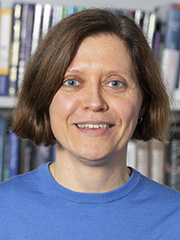Dr. rer. nat. Cordula Hölig

Foto: UHH, RRZ/MCC, Mentz
Wissenschaftliche Mitarbeiterin für Lehre, Postdoc
Anschrift
Büro
Kontakt
Sprechstunde
Dienstag, 9-10 Uhr (nach vorheriger Anmeldung per E-Mail)
Lebenslauf
| seit 2017 | Postdoc, Biologische Psychologie und Neuropsychologie, Universität Hamburg |
| seit 2010 | Wissenschaftliche Mitarbeiterin mit dem Schwerpunkt Lehre, Biologische Psychologie und Neuropsychologie, Universität Hamburg |
| 2017 | Promotion zum Dr. rer. nat., Universität Hamburg Thema der Dissertation: "Cerebral Correlates of Person Recognition in Sighted and Blind Humans“ |
| 2006-2010 | Wissenschaftliche Mitarbeiterin, Institut für Systemische Neurowissenschaften, Universitätsklinikum Hamburg-Eppendorf, Hamburg (Prof. Dr. Christian Büchel) |
| 2003-2004 | Visiting Student, McGill University, Montréal, Canada |
| 2000-2006 | Studium der Psychologie, Johannes Gutenberg-Universität Mainz Thema der Diplomarbeit: "Aufmerksamkeitssteuerung bei aufgabenirrelevanten und -relevanten Störungen: eine EKP-Studie“ |
Publikationen
Heitmann, C., Zhan, M., Linke, M., Hölig, C., Kekunnaya, R., van Hoof, R., Goebel, R., & Röder, B. (2023). Early visual experience refines the retinotopic organization within and across visual cortical regions. Current Biology, 33(22), 4950-4959.e4. https://doi.org/10.1016/j.cub.2023.10.010
Hölig, C., Kekunnaya, R., & Röder, B. (2023, May 12). Adversity in early childhood can impair brain development. Scientific American. https://www.scientificamerican.com/article/adversity-in-early-childhood-can-irreversibly-impair-the-brain/
Hölig, C., Guerreiro, M. J. S., Lingareddy, S., Kekunnaya, R., & Röder, B. (2023). Sight restoration in congenitally blind humans does not restore visual brain structure. Cerebral Cortex, 33(5), 2152–2161. https://doi.org/10.1093/cercor/bhac197
Rączy, K., Hölig, C., Guerreiro, M.J.S., Lingareddy, S., Kekunnaya, R., & Röder, B. (2022). Typical resting state activity of the brain requires visual input during an early sensitive period. Brain Communications, 4(4), fcac146. doi: 10.1093/braincomms/fcac146
Rogge, A.-K., Hötting, K., Nagel, V., Zech, A., Hölig, C. & Röder, B. (2019). Improved balance performance accompanied by structural plasticity in blind adults after training. Neuropsychologia, 129, 318-330. https://doi.org/10.1016/j.neuropsychologia.2019.04.005.
Hölig, C., Föcker, J., Best, A., Röder, B., & Büchel, C. (2017). Activation in the angular gyrus and in the pSTS is modulated by face primes during voice recognition. Human Brain Mapping, 38(5), 2553-2565. doi.org/10.1002/hbm.23540
Föcker, J., Hölig, C., Best, A., Röder, B. (2015). Neural plasticity of voice processing: Evidence from event-related potentials in late-onset blind and sighted individuals. Restor. Neurol. Neurosci. 33, 15–30. doi:10.3233/RNN-140406
Hölig, C., Föcker, J., Best, A., Röder, B., Büchel, C. (2014). Crossmodal plasticity in the fusiform gyrus of late blind individuals during voice recognition. NeuroImage 103, 374–382. doi:10.1016/j.neuroimage.2014.09.050
Hölig, C., Föcker, J., Best, A., Röder, B., & Büchel, C. (2014). Brain systems mediating voice identity processing in blind humans. Human Brain Mapping, 35(9), 4607-4619. doi: 10.1002/hbm.22498
Kassuba, T., Klinge, C., Hölig, C., Röder, B., Siebner, H.R. (2014). Short-term plasticity of visuo-haptic object recognition. Front. Psychol 5, 274. doi:10.3389/fpsyg.2014.00274
Kassuba, T., Klinge, C., Hölig, C., Röder, B., & Siebner, H. R. (2013). Vision holds a greater share in visuo-haptic object recognition than touch. NeuroImage, 65, 59–68. doi:10.1016/j.neuroimage.2012.09.054
Föcker, J., Best, A., Hölig, C., & Röder, B. (2012). The superiority in voice processing of the blind arises from neural plasticity at sensory processing stages. Neuropsychologia, 50(8), 2056–2067. doi:10.1016/j.neuropsychologia.2012.05.006
Föcker, J., Hölig, C., Best, A., & Röder, B. (2011). Crossmodal interaction of facial and vocal person identity information: an event-related potential study. Brain Research, 1385, 229–245. doi:10.1016/j.brainres.2011.02.021
Kassuba, T., Klinge, C., Hölig, C., Menz, M. M., Ptito, M., Röder, B., & Siebner, H. R. (2011). The left fusiform gyrus hosts trisensory representations of manipulable objects. NeuroImage, 56(3), 1566–1577. doi:10.1016/j.neuroimage.2011.02.032
Hölig, C., & Berti, S. (2010). To switch or not to switch: brain potential indices of attentional control after task-relevant and task-irrelevant changes of stimulus features. Brain Research, 1345, 164–175. doi:10.1016/j.brainres.2010.05.047
Meinhardt, G., Persike, M., Mesenholl, B., & Hagemann, C. (2006). Cue combination in a combined feature contrast detection and figure identification task. Vision Research, 46(23), 3977–3993. doi:10.1016/j.visres.2006.07.009
